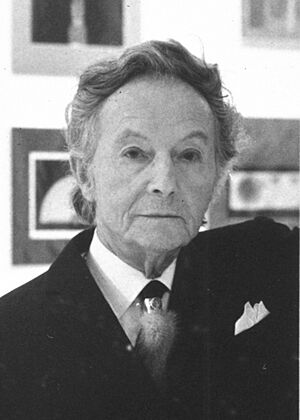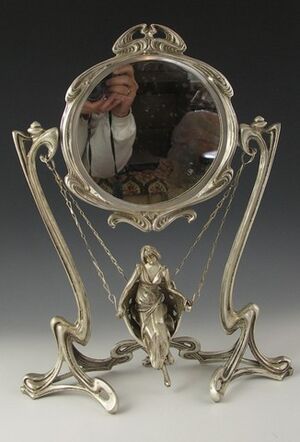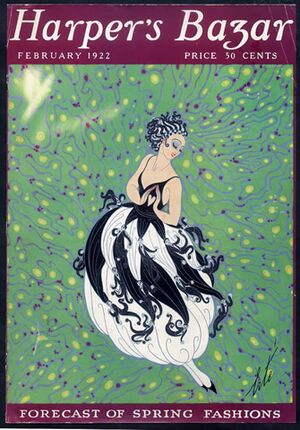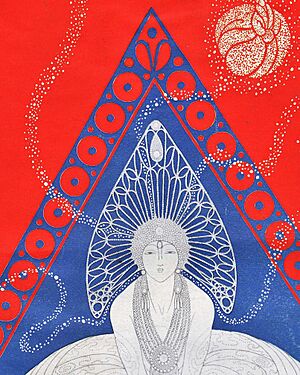Erté facts for kids
Quick facts for kids
Erté
|
|
|---|---|

Erté in front of his works at the Sonnabend Gallery, New York City, 1970
|
|
| Born |
Romain Petrovich de Tirtoff
23 November 1892 |
| Died | 21 April 1990 (aged 97) |
| Nationality | Russian, French |
| Movement | Art Deco |
Romain de Tirtoff (born November 23, 1892 – died April 21, 1990) was a famous Russian-born French artist. He was known as Erté, which comes from the French way of saying his initials.
Erté was a talented designer in many areas. He created fashion, jewelry, graphic art, and costumes and sets for movies, plays, and operas. He also designed interiors. His work is a great example of the Art Deco style.
Contents
Early Life and Artistic Dreams
Erté was born Roman Petrovich Tyrtov in Saint Petersburg, Russia. His family was well-known, and his father was an admiral in the Russian Navy.
From a young age, Erté was interested in theater and dance. However, he soon realized his true passion. He once said, "I came to the conclusion that I could live without dancing but could not give up my passion for painting and design."
Starting His Career in Paris
In 1907, when he was just 15, Erté created a sculpture called Demoiselle à la balancelle. This was one of his first sculptures. It showed an early interest in the Art Nouveau style.
Between 1910 and 1912, Erté moved to Paris to become a designer. His father did not want him to go, wishing him to join the navy. To avoid upsetting his family, Romain started using the name Erté.
He began working for the famous designer Paul Poiret from 1913 to 1914.
Success in Magazines and Theater
In 1915, Erté got his first big job with Harper's Bazaar magazine. This started his amazing career. He designed over 200 covers for Harper's Bazaar between 1915 and 1937. His drawings also appeared in other popular magazines like Illustrated London News, Cosmopolitan, and Vogue.
Erté is most famous for his elegant fashion designs. These designs perfectly show the Art Deco period. His unique style, with delicate figures and glamorous looks, is easy to spot. His ideas still influence fashion today.
He also designed costumes and sets for many famous shows. These included the Ziegfeld Follies of 1923 and many productions at the Folies Bergère in Paris.
Designing for Hollywood
In 1925, a movie producer named Louis B. Mayer brought Erté to Hollywood. He was hired to design sets and costumes for the silent film Paris.
Because of script problems, Erté worked on other films too. He designed for movies like Ben-Hur and Dance Madness.
Famous Artworks and Later Career
One of Erté's most well-known images is Symphony in Black. It shows a tall, slender woman in black, holding a thin black dog on a leash. This influential image has been copied many times.
Erté continued to work throughout his life. He designed for revues, ballets, and operas. In the 1960s, there was a new interest in the Art Deco style, which brought his work back into the spotlight. He started creating limited edition prints, bronze sculptures, and even art that people could wear.
Two years before he passed away, Erté designed seven special bottles for Courvoisier, a famous cognac company. These bottles showed the different steps of making cognac. In 2008, the eighth and final bottle in this series was released.
Where to See His Work
Erté's art can be found in many famous museums. These include the Victoria and Albert Museum in London, the Metropolitan Museum of Art in New York, and the Los Angeles County Museum of Art (LACMA). There is also a large collection of his work at Museum 1999 in Tokyo.
Images for kids
-
Erté evening dress in beaded lamé, exhibited in the Rijksmuseum
See also
 In Spanish: Erté para niños
In Spanish: Erté para niños
- Dudnikov v. Chalk & Vermilion Fine Arts, Inc.: A U.S. court case over copyrights of Erté's works







